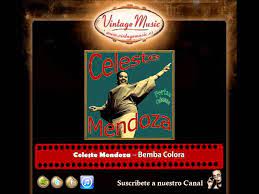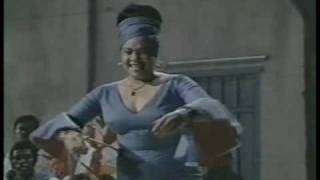CELESTE MENDOZA, DESTACADA CANTANTE CUBANA CONOCIDA COMO “LA REINA DEL GUAGUANCÓ”. VIDEOS.
Celeste Mendoza Beltrán fue una destacada cantante cubana más conocida en el mundo musical y artistico como ‘La Reina del Guaguanco”; una intérprete emblemática del guaguancó que supo transmitir en la voz y el movimiento corporal, la sensualidad, picardía y emotividad que demanda el género.
Celeste Mendoza nació en la ciudad de Santiago de Cuba, el 6 de abril de 1930, en el popular barrio de Los Hoyos. En 1943, con trece años de edad, la trasladaron para La Habana donde se dio a conocer en un programa radial de aficionados por su interpretación de “El marañón”, una creación de Julio Cuevas.
Recibió lecciones de baile, impartidas por su primo Jorge Beltrán, con quien posteriormente formó pareja.
CARRERA ARTISTICA
En 1950 se presentó en el Teatro Martí en calidad de bailarina de la Compañía Batamú. También se presentó en el Cabaret Mi Bohío ubicado en la zona playera de la barriada de Marianao.
VIDEOS- Celeste Mendoza canta “Echame a …”
En 1951 se incorporó al cuerpo de baile del Cabaret Tropicana, bajo la dirección de Roderico Neyra; donde la Mendoza, durante la visita de las cantantes Josephine Baker y Carmen Miranda, hizo geniales imitaciones de éstas, con las que ganó el aplauso y la admiración del público presente. Ese mismo año integró un cuarteto vocal-instrumental con Omara Portuondo, Gladys León e Isaura Mendoza (su hermana), bajo la dirección del pianista y compositor Facundo Rivero.
En 1952 se inició como cantante solista y se presentó en el programa Alegrías de Hatuey transmitido por Radio Progreso, con el acompañamiento de la orquesta conducida por el Maestro Ernesto Duarte.
En 1953, debutó en la televisión, en el programa “Esta Noche” en CMQ, dirigido por Joaquín M. Condall. Cantó a dúo con Miguel de Gonzalo. Fue una de las primeras en interpretar el bolero ranchera, sobre todo cuando cantó “Que me castigue Dios”, del mexicano José Alfredo Jiménez, acompañada por la orquesta de Ernesto Duarte y sus interpretaciones, de cualquier género, lo hacía en tiempo de guaguancó.
Realizó presentaciones en el Teatro Blanquita y tuvo contratos en diversos centros nocturnos de La Habana en los que popularizó canciones al estilo de Soy tan feliz. Su personalísima interpretación se convirtió en un éxito de la difusión.
Actuó junto a Benny Moré, Fernando Álvarez y Blanca Rosa Gil; también con Los Papines, la orquesta Aragón y el Conjunto Sierra Maestra. Aparece en el filme cubano del realizador Rogelio París: “Nosotros la música”.
Participó en los festivales de música popular de 1962 y 1963. Realizó giras por México, Puerto Rico, Venezuela, Panamá, Estados Unidos y actuó en el teatro Olimpia, París, Unión Soviética y Japón.
Siguieron giras artísticas por países de Europa y Latinoamérica y una intensa actividad en programas radiales y espectáculos donde tuvo la oportunidad de compartir el escenario con figuras tan famosas como Benny Moré, Ignacio Villa (Bola de Nieve), Edith Piaf, Ninón Sevilla, Carmen Miranda, Josephine Baker y Pedro Infante.
Integró el elenco del Music Hall que se presentó en la capital francesa, con el atractivo de agrupaciones y figuras como la Orquesta Aragón, Los Papines y Elena Burke, en 1964.
Firmó contratos con la televisión francesa y se presentó ante el público de Berlín, Moscú y Leningrado.
A su regreso a Cuba fue ovacionada en teatros y espectáculos de cabarets y se convirtió en la protagonista de otros cuatro documentales producidos por el ICAIC. Actuó, igualmente, en una película con Tin Tan, Tin Tan en La Habana, y un corto musical para la televisión francesa.
En sus discos, reeditados en Venezuela, Francia y Canadá, la rumba ocupa un lugar muy destacado, así como otros géneros y autores de la cancionística cubana y latinoamericana.
PREMIOS
En su larga carrera artística recibió numerosos reconocimientos. En la Feria Internacional CUBADISCO 1998 fue galardonada, junto al grupo musical Los Papines, por el disco El reino de la rumba.
DISCOGRAFIA
DC: La soberana
(LD-GEMA): Celeste Mendoza (1106), 1962;
Celeste Mendoza, la reina del guaguancó (1148);
(LD-SEECO):La voz de Celeste Mendoza (9217), 1961;
(Todos LD-EGREM): Aquí el guaguancó (3174), 1966;
Celeste Mendoza (4378);
Celeste Mendoza, la reina del guaguancó (5426), 1988;
Celeste Mendoza con Sierra Maestra (4669), 1990;
Celeste Mendoza y los Papines.
(Todos DC-EGREM): La Reina y el Bárbaro (022), 1992;
El reino de la rumba (236), 1997;
Celeste Mendoza con Sierra Maestra (303), 1998;
La soberana (517), 2001.
SUS MEJORES INTERPRETACIONES…
El pueblo de Cuba recuerda las interpretaciones que hizo de obras como:
Échame a mi la culpa,
Que me castigue Dios y
Papá Oggún
pero, sobre todo, su destreza para manejar el guaguancó, la guaracha, o para asumir combinaciones genéricas en las que boleros o rancheras incrementaban su interés musical y danzario a partir de estructuras rítmicas propias del mambo y de la rumba.
Al decir de Rita Montaner…..“verdadera artista cubana, que expresa en lo vocal y lo coreográfico, con espontaneidad, sin dobleces, nuestra música popular y folklórica”. ¡La reina del Guaguancó!
Celeste Mendoza falleció en La Habana, el 22 de noviembre de 1998.
CELESTE MENDOZA, OUTSTANDING CUBAN SINGER KNOWN AS “LA REINA DEL GUAGUANCÓ”. PHOTOS. VIDEOS.
Celeste Mendoza Beltrán was an outstanding Cuban singer better known in the musical and artistic world as ‘La Reina del Guaguanco’, an emblematic interpreter of the guaguancó who knew how to transmit in her voice and body movement, the sensuality, mischief, and emotion that the genre demands.
Celeste Mendoza was born in the city of Santiago de Cuba, on April 6, 1930, in the popular neighborhood of Los Hoyos. In 1943, at the age of thirteen, she was transferred to Havana where she became known in an amateur radio program for her interpretation of “El marañon”, a creation by Julio Cuevas.
She received dance lessons, taught by her cousin Jorge Beltrán, with whom she later formed a couple.
ARTISTIC CAREER
In 1950 she appeared at the Martí Theater as a dancer for the Batamú Company. She also performed at the Cabaret Mi Bohío located in the beach area of the Marianao neighborhood.
In 1951 she joined the Tropicana Cabaret dance team, under the direction of Roderico Neyra; were Mendoza, during the visit of the singers Josephine Baker and Carmen Miranda, did great imitations of them, with which she won the applause and admiration of the public present. That same year she joined a vocal-instrumental quartet with Omara Portuondo, Gladys León, and Isaura Mendoza (her sister), under the direction of pianist and composer Facundo Rivero.
In 1952 she began as a solo singer and appeared on the Alegrías de Hatuey program broadcast by Radio Progreso, with the accompaniment of the orchestra conducted by Maestro Ernesto Duarte.
In 1953, she made her debut on television, in the program “Esta Noche” on CMQ, directed by Joaquín M. Condall. She sang a duet with Miguel de Gonzalo. She was one of the first to interpret the bolero ranchera, especially when she sang “Que me castigue Dios”, by the Mexican José Alfredo Jiménez, accompanied by the orchestra of Ernesto Duarte and his interpretations, of any genre, she did it in guaguancó time.
She made presentations at the Blanquita Theater and had contracts in various nightclubs in Havana in which she popularized songs in the style of Soy tan Feliz. Her highly personal performance became a broadcast hit.
She acted alongside Benny Moré, Fernando Álvarez, and Blanca Rosa Gil; she also with Los Papines, the Aragón orchestra, and the Sierra Maestra Ensemble. She appears in the Cuban film by director Rogelio Paris: “Nosotros la musica”.
She participated in the popular music festivals of 1962 and 1963. She toured Mexico, Puerto Rico, Venezuela, Panama, and the United States and performed at the Olimpia theater, Paris, the Soviet Union, and Japan.
Artistic tours of Europe and Latin America followed, along with intense activity in radio programs and shows where he had the opportunity to share the stage with such famous figures as Benny Moré, Ignacio Villa (Bola de Nieve), Edith Piaf, Ninón Sevilla, Carmen Miranda. , Josephine Baker and Pedro Infante.
She joined the cast of the Music Hall that was presented in the French capital, with the attraction of groups and figures such as the Orquesta Aragón, Los Papines, and Elena Burke, in 1964.
She signed contracts with French television and appeared before audiences in Berlin, Moscow, and Leningrad.
Upon her return to Cuba, she was applauded in theaters and cabaret shows and became the protagonist of four other documentaries produced by ICAIC. She also acted in a film with Tin Tan, Tin Tan in Havana, and a short musical for French television.
In her records, reissued in Venezuela, France, and Canada, the rumba occupies a very prominent place, as well as other genres and authors of Cuban and Latin American songwriting.
AWARDS
In her long artistic career, she received numerous awards. At the 1998 CUBADISCO International Fair, she was awarded, together with the musical group Los Papines, for the album El Reino de la Rumba.
DISCOGRAPHY
DC: The sovereign
(LD-GEMA): Celeste Mendoza (1106), 1962;
Celeste Mendoza, the queen of guaguancó (1148);
(LD-SEECO): The voice of Celeste Mendoza (9217), 1961;
(All LD-EGREM): Here the guaguancó (3174), 1966;
Celeste Mendoza (4378);
Celeste Mendoza, the queen of guaguancó (5426), 1988;
Celeste Mendoza with Sierra Maestra (4669), 1990;
Celeste Mendoza and the Papines.
(All DC-EGREM): The Queen and the Barbarian (022), 1992;
The kingdom of the rumba (236), 1997;
Celeste Mendoza with Sierra Maestra (303), 1998;
The sovereign (517), 2001.
HER BEST INTERPRETATIONS …
The people of Cuba remember the interpretations of her that she made of her works such as:
Blame me,
God punish me and
Papa Oggun
but, above all, her ability to handle the guaguancó, the guaracha, or to assume generic combinations in which boleros or rancheras increased her musical and dance interest based on rhythmic structures typical of mambo and rumba.
In the words of Rita Montaner…..“true Cuban artist, who expresses vocally and choreographically, spontaneously, without duplicity, our popular and folk music”. The queen of Guaguancó!
Celeste Mendoza died in Havana on November 22, 1998.
Agencies/ Wiki/ Ecured/ CelesteMendozaBio./ Extractos/ Excerpts/ Internet Photos/ YouTube/ Arnoldo Varona/ www.TheCubanHistory.com
THE CUBAN HISTORY, HOLLYWOOD.









